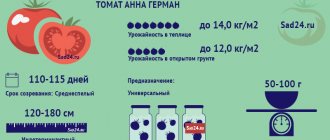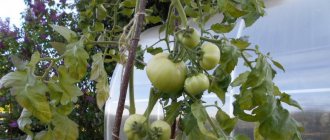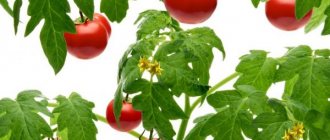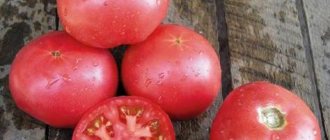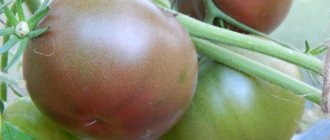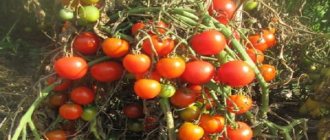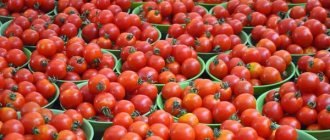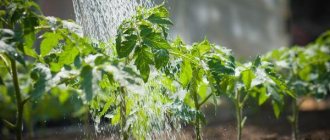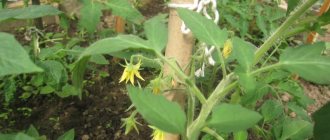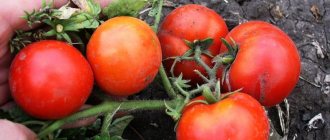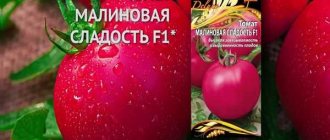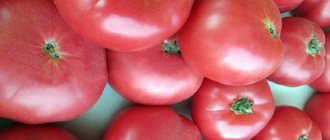The Watercolor tomato variety, bred by breeders in Siberia, pleases gardeners with its unpretentiousness both in open ground and in greenhouse conditions.
| Height | Landing location | Ripening time | Fruit color | Fruit size | Origin | Fruit shape |
| short | Greenhouse, Open ground | Early ripening | Reds | Small | Variety | Plum-shaped or oval |
Description and characteristics of the variety
Watercolor is considered a tomato variety with a limited bush growth of 50 cm, giving a bountiful harvest under any climatic conditions. Characterized by thick and strong stems capable of holding fruits. The variety is early ripening, the period of fruit ripening is 100-120 days after full germination.
Features of cultivation, planting and care
sowing the seeds of this tomato variety for seedlings 60-65 days before the intended planting in the ground . Since this is a standard plant, per 1 sq. meter of plot can accommodate 6-8 plants.
Further care for tomatoes consists of timely watering, fertilizing with complex mineral fertilizer, weed removal and preventive measures to protect against diseases and pests.
The tomato variety Aquarelle is included in the State Register of the Russian Federation for cultivation in open ground in private household plots.
Be sure to check out the selection of the Best tomatoes for open ground
If you grew Watercolor tomatoes, please write whether you liked it or not. Will you grow it again? Briefly describe the advantages and disadvantages of this tomato in your opinion. If possible, attach to the comment a photo of the entire bush as a whole or individual fruits that you grew. Thank you!
Your reviews of the Watercolor tomato and additions to the description will help many gardeners evaluate this variety objectively and decide whether it is worth planting or not.
This is a natural variety of tomato. Therefore, we recommend taking seeds from a ripe fruit and using them for planting in subsequent seasons.
Reviews:
Galina Aleksandrovna S, pensioner:
The purchased bag contained 27 seeds of the Aquarelle variety. Before planting, I kept them in an infusion of wood ash and germinated them in a damp cloth until roots appeared. 24 germinated. I hardened them and sowed them in boxes. 22 seedlings survived to picking.
In mid-March, I planted them in individual pots. Two weeks later I fed her with Agricola. The seedlings turned out to be stocky and did not stretch out. I planted it in the garden in mid-May. She didn’t cover it with anything. I even tied up the low bushes. I was pleased with the harvest. Even without special care (there was not enough time to complete all the necessary work), the harvest collected from 21 bushes was enough for our entire large family and was left for spinning.
Tomato "Aquarelle" is a mid-early, productive, determinate tomato. Developed by Siberian breeders and recommended for cultivation in open ground and in various types of film shelters.
Varietal characteristics
The Watercolor tomato belongs to the category of determinate – low-growing – tomatoes. The variety is mid-early and produces large yields. The main external difference between Watercolor and other tomatoes is its massive, powerful stem, which quite often does not even need garters or additional supports. Only when the harvest begins to ripen and the fruits are in contact with the ground can the bush be supported so that the tomatoes do not spoil.
Watercolor tomato leaves are ordinary, their color is rich green. The height of one bush is only 50 centimeters. With proper planting, care, and fertilization, the Aquarelle tomato produces a consistently good harvest in regions with very different climates. The first ovary appears on the bushes after 4-5 leaves. Each branch bears six identical fruits. Their weight is almost always the same, their shape is round and plum-shaped. One tomato can weigh from 60 to 100 grams, which suits housewives who like to prepare homemade preserves.
Growing seedlings
To get a good harvest of Watercolor tomatoes, you need to use the seedling method when growing.
Sowing work should be planned at the end of February. It is recommended to purchase planting material from trusted places and plant it in plastic containers and cups filled with nutrient substrate.
To increase seed germination, the following procedure is required:
- Cover the containers with nutritious soil enriched with mineral and organic fertilizers.
- Sow seeds into the soil to a depth of no more than 1 cm.
- Water with warm water, temperature up to 20 degrees.
Subsequently, the seedlings are watered at intervals of 10 days. It is important not to overdo it so as not to erode the soil and expose the young root system.
Intensive seed germination is possible only at a temperature of at least 23 degrees. The humidity level should not exceed 65-70%.
If all conditions for growth and planting rules are met, the first shoots will appear within a week.
A special plant growth stimulator will help speed up the emergence of seedlings. The drug Epin is popular among summer residents.
The period from sowing seeds to planned planting in open ground is 60-65 days.
Watercolor tomato seedlings are transplanted into beds 2 months after planting the seeds. A delay of 8 days is allowed, but no more.
Planting in the ground and care
You can plant seedlings in open ground in late April - early May. The landing site should be well lit by the sun, protected from strong winds. The most successful predecessors of tomatoes are legumes and carrots.
For successful cultivation, it is necessary to properly plant seedlings, which consists of the following steps:
- Distribute the territory according to the scheme for 1 sq. m. 4 tomato bushes.
- Dig holes no more than 20 cm deep, add mineral fertilizers to the bottom and fill with water to the very edges.
- Lower the seedling into the hole, evenly distributing the root system and sprinkle with soil.
The Watercolor tomato variety does not require special care, but for successful growth and harvest, the following agrotechnical practices should be implemented:
- Remove leaves and shoots in a timely manner. The procedure is carried out several times a season, as excess shoots appear. Also trim at least 3 lower stepsons per week. Thanks to this procedure, all nutrients will be aimed at the formation of fruits.
- Feed the plant. Spray the upper part with mineral solutions to accelerate growth and rapid crop formation.
- After flowering and the formation of three inflorescences, treat the plants with a 20% bromine solution. This will accelerate the growth and formation of fruits.
- Hill up and mulch to strengthen the root system. Before hilling, the plant is watered. Hay, sawdust, pine needles, and compost are used as mulch.
- Remove weeds, loosen the beds to saturate the soil with moisture and prevent the appearance of crust.
- Water at all stages of crop development, which will allow the tomatoes to become sweet and juicy.
Similar varieties
According to the characteristics and description of the variety, the Watercolor tomato is in many ways similar to such varieties of tomatoes as:
Slivovka was bred by Siberian breeders. Early variety. It has a determinate type of bush up to 40 cm high. The fruits in appearance resemble Watercolor tomatoes, but are somewhat larger than the latter.
Large cream is a low-growing variety of tomatoes with a ripening period of 105-110 days. The fruits have a plum-shaped shape, as indicated by the name of the vegetable crop. The plant is resistant to late blight, verticillium and fusarium. Suitable for growing in open ground.
Maryushka is a determinate plant with a medium-early ripening period. The variety tolerates temperature changes well and is resistant to major tomato diseases. The red fruits resemble cream. The weight of one tomato is 60-70 g.
Characteristics
The category was developed for fairly harsh growing conditions.
One of the distinctive features is the absence of the need to break off stepsons and plant seedlings in open soil without the use of special greenhouses. It was developed by Siberian agronomists. Apparently the shelter is in film-type greenhouses. It ripens quickly enough and produces a good harvest. Sowing occurs in March, in May - planting in the ground. In the first half of July you can expect a harvest.
The ripening conditions depend on the climate of the region: humidity, bright days and temperature conditions, as well as plant care.
The stem is very powerful, holds the ovary and pomona gifts well. It does not require a garter to any support; it is well fixed in person due to its thick trunk. However, it is necessary to support the fruits themselves so that the tomatoes do not come into contact with the soil. This is the only way to avoid unexpected rotting of the vegetable on the ground, as well as the transfer of rot to other fruits.
Flowers, and after them the ovary and the first fruits, form on the fifth leaf. During the season, formation is possible long before. Ant. from eight groups of inflorescences and ripened tomatoes.
Description of the Parodist tomato variety, cultivation features
Tomatoes are a valuable source of vitamins and minerals. The beneficial qualities of the plant have made it popular among gardeners. The Parodist tomato was cultivated by Russian breeders and received recognition outside its native land.
General information about the plant
The variety is included in the State Register and is characterized by a high rate of berry ripening. Description of the variety and external qualities:
- Early ripening, berries are harvested already in 80–85 days.
- Determinant.
- Low growing, up to 0.5 meters.
- Compact.
- Powerful root system.
- Regular sheet type.
- Simple inflorescence.
- The number of inflorescences per stem is 3–4.
- Up to 6 fruits are tied on one brush.
- Good fruit set in unfavorable conditions.
- Friendly return of the harvest.
- Average yield, per bush up to 3.5 kilograms.
- Resistance to late blight and cladosporiosis.
- Short-term storage possible.
- Does not tolerate transportation well.
- Salad purpose.
Reviews from Ukrainian, Moldavian and Russian gardeners confirm the positive taste of the fruit. Characteristics and appearance of berries:
- Flat-round shape.
- Pronounced ribbing.
- Bright red color.
- Average weight no more than 160 grams.
- Thin, durable skin.
- Not prone to cracking.
- Dense.
- Good taste.
- Juicy.
- Not watery.
Tomatoes are classified as salad type. The berries are suitable for fresh consumption, stuffing, and as an ingredient for vegetable salads. The variety is chosen for drying and preparing preparations.
Recommendations for cultivation
Tomatoes are grown in different regions of Russia. The plant's resistance to stress and the ripening of fruits under cool summer conditions have expanded the boundaries of cultivation of the variety. The method of cultivation depends on the climatic characteristics of the region, preferably a protected place - a greenhouse or greenhouse. Planting method: seedlings.
The production of healthy seedlings is facilitated by:
- Plant seeds 1–2 centimeters deep.
- Timely watering.
- Setting the temperature in the room.
- Place the seedlings in a well-lit place.
- The duration of daylight is at least 16 hours.
- Pre-hardening, a week before planting.
The variety is not whimsical. It can be planted densely; up to nine bushes feel comfortable on one square meter. The planting scheme recommended by the originator is 50 x 40 cm. For successful growth, it is enough to follow the established rules of agricultural technology for low-growing tomatoes: water, feed, loosen and weed.
IMPORTANT! The variety does not require shaping or pinching
Gardeners' opinion
Good day to all! Last summer, a neighbor at his dacha grew a Parodist tomato variety. After his successful experience, I decided to plant the variety myself. Given the cool summer, I was pleased with the harvest. I cultivated it in a greenhouse and planted the tomatoes tightly. A compact, low-growing plant allows you to place up to 9 bushes per square meter. The unpretentious tomato needs watering; over the summer I fed it 6 times, loosened it and removed weeds. There were no difficulties; I grew sweet berries. I recommend!
Ekaterina Varvavaikina, 55 years old
Good afternoon! This summer I planted a new tomato variety, Parodist. The tomato is stress-resistant to adverse weather conditions. Does not require additional care measures. An early ripening variety does not need to be tied up or supported. Loves feeding and abundant watering. Seedlings can be planted densely; the tomato is very compact. The fruits turned out to be quite large, each weighing about 150 grams. Suitable for salads and fresh consumption, I tried drying it. I didn’t find any cons for myself!
Alexander Domodedov, 55 years old
General information about the variety
The stems of this variety of tomatoes do not need pinching or staking, because their growth is limited. According to the characteristics, the height of the bushes does not exceed half a meter. They are compact in size, somewhat reminiscent of small trees covered with fruits. This comparison suggests itself due to the thick, powerful trunk. The leaves of this variety are small and dark green in color.
Interestingly, fruit set begins after the fourth leaf. Each brush produces six identical-sized tomatoes. Their shape is oval and their color is bright red. The photographs confirm the accuracy of the description of the variety. A yellowish area stands out near the petiole.
Ask and receive useful advice from professional gardeners and experienced summer residents.>>
Watercolor tomatoes are good canned. Thanks to their dense peel, they retain their integrity during heat treatment.
Advantages and disadvantages of the variety
The main advantages of the Watercolor tomato variety include:
- high yield rates;
- excellent taste and appearance characteristics;
- ease of care;
- non-susceptibility to diseases such as septoria, blossom end rot;
- the possibility of growing both in open beds and in greenhouse conditions;
- preservation of presentation during transportation;
- versatility in use (the fruits are good fresh or canned).
The only drawback, according to reviews from gardeners, is the hardness of the skin of the fruit.
The advantages of the Watercolor tomato variety significantly outweigh the disadvantages, which explains its popularity among experienced gardeners.
Compliance with the rules of agricultural technology will allow you to grow strong vegetable bushes that will delight you with a harvest of high-quality fruits.
Reviews:
I’ve been growing the “Aquarelle” tomato for several years now, and I’m very pleased with the harvest. The fruits are plum-shaped, small, have a long shelf life, and are perfect for canning. I liked the variety because it does not require special care. There is no need to tie them up or constantly cut off excess shoulder straps. Fresh and canned tomatoes are very tasty, my family is delighted with them.
I was pleasantly surprised when I harvested the first harvest of the “Aquarelle” tomato. From one square meter about 7 kilograms. Every bush was strewn with tomatoes, which made me very happy. During ripening, I sprayed the plants against late blight and that’s it. The fruits are elastic, sugary, pleasant to the taste, not sour.
The Watercolor tomato will become one of your favorite nightshades that you planted on your site. The best breeders worked on developing this variety, so it will not disappoint you!
Reviews from gardeners
Sidorenko Oksana Valerievna, 45 years old, Moscow:
“I purchased watercolor tomato planting material on the advice of a neighbor. I sowed the seeds and transplanted the grown seedlings two months later into open ground. I cared for the crop according to the recommendations. As a result, I got an excellent harvest. The fruits have a pleasant taste. I’ve prepared a lot of preserves, now I’ll please my family in winter.”
Sedoy Igor Vladimirovich, 50 years old, Ekaterinburg:
“Children and grandchildren love tomatoes very much, so every year I grow them in huge quantities so that they have enough to eat and make homemade preparations for the winter. I have long identified the best tomato variety as Watercolor, which is suitable both in taste and in terms of soil and climate requirements. Every year the harvest surprises me with its quality and quantity.”
Olga Petrovna Makeeva, 63 years old, Voronezh:
“I grow Watercolor tomatoes for sale. They are in great demand and at the same time unpretentious and frost-resistant. The presentation is preserved for a month, which is important in trade. If you follow all care recommendations, you can get a stable high yield.”
With proper agricultural technology, Watercolor tomatoes bring a rich and early harvest. The variety is ideal for growing in open and protected ground.
Features of caring for the variety
“Aquarelle” tomatoes were specially adapted by the developers of this variety for growing in open ground. An unpretentious, cold-resistant tomato, suitable for industrial cultivation in vegetable farms. The yield of this tomato variety is about 8 kg per 1m2.
- Direct sowing of tomatoes of this variety in the ground is also recommended, however, the growing season of the plant is lengthened, and under such conditions it is impossible to obtain an early harvest. Aquarelle seeds are sown 6-8 weeks from the last expected frost date in the region. Sowing is carried out in illuminated warm rooms, heated greenhouses or greenhouses. Optimal germination of sprouts occurs after 7 days, at a constant humidity of 60-70%, and a soil temperature of 22-23 degrees.
- An important point for obtaining healthy and fertile tomato seedlings is the optimal combination of humidity and temperature. Watering is carried out every 10-12 days, but more often is possible. The temperature characteristics of the soil during irrigation should be no higher than 24 degrees, and the optimal water temperature is 20 degrees.
- Planting of ready-made tomato seedlings is carried out according to the 50 x 40 cm scheme, 3-4 plant bushes per 1 m2. It is possible to plant up to 5 bushes per 1 m2.
- Proper and timely application of fertilizers, mulching, loosening the soil on the plot of land chosen for planting is an integral part and the key to the profit of the farm.
Tomato Watercolor: fruit characteristics
Due to the fact that tomato bushes, due to their large trunk, look like a small tree, the fruits can be located quite densely on it. The pulp of tomatoes is dense and fleshy. The tomato has a pleasant sweetish taste. The cross-section shows that the Watercolor tomato (pictured above) has two chambers with a small number of seeds. A characteristic feature of the variety is what gardeners call small yellowish spots that are located on the tomatoes near the stalk. The harvest is easily removed from the bush, the branches are not damaged. Many vegetable growers recommend using special machines for harvesting.
Thanks to their dense skin and structure, tomatoes of this variety are ideal for long-term transportation. The fruits can be used to prepare tomato paste and various preserves. Bright tomatoes, identical in color and size, look very appetizing in jars. Tomatoes are good for making salads and sandwiches.
According to reviews from experienced gardeners, the variety allows you to get a pretty good harvest: from one square meter you can harvest from 6 to 9 kilograms of tomatoes. It is worth noting that after removing tomatoes from the bush, they can be stored for about a month in a cool room. So, the Watercolor variety can be called very profitable for large-scale industries where tomato products are created, as well as restaurants and other catering establishments.
